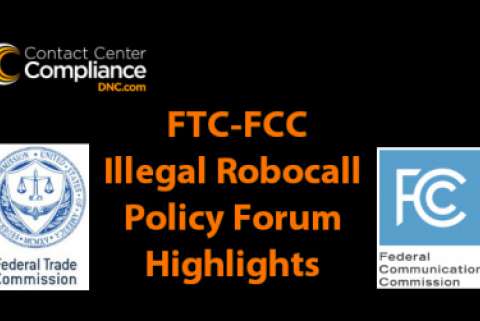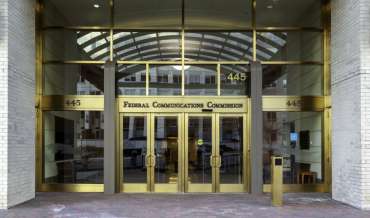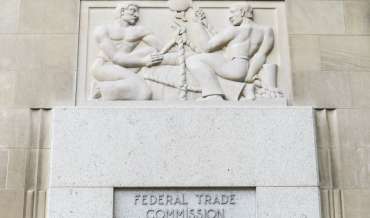On Friday, March 23, the FCC-FTC held the first of two scheduled forums addressing illegal robocalls. This first meeting brought together telecommunications experts and officials from the FCC and FTC to discuss ways for dealing with the growing problem of illegal robocalls. What wisdom can we gleam from these important discussions between industry leaders and policy regulators?
In setting the tone for the discussion panels FCC Chairman Ajit Pai welcomed everyone with these opening remarks:
“This cross-agency event reflects the importance of the issue of unwanted robocalls. Today’s collaboration brings together not only the FCC and the FTC, but also other leaders in government, the private sector, and the non-profit community. The unfortunate inventiveness of scammers, technical challenges, and sheer volume of calls are daunting for any one entity to defeat. But working together, we have a better chance.”<
The forum lasted three hours and consisted of three panels each focused on different areas of combating illegal robocalls. While the forum did not offer any revelations, it did provide an opportunity for government agencies, telemarketing industry, and consumer advocates to demonstrate a united front. If anything, the discussions showed their agreement that illegal robocalls are demonizing the telemarketing industry and that the growing number of consumer complaints have made finding a solution their top priority.
Panel 1 - Challenges Facing Consumers and Industry Today
The panel agreed that information sharing is important for identifying the source of illegal robocalls. Industry representatives were appreciative of the level of information sharing between the government agencies and the telecommunications industry. There were especially appreciative of the FTC’s daily release of complaint information which they saw as crucial to their responding appropriately to complaints from consumers.
Robocall scams occur because they are profitable and the technology used is cheap and easy to setup. The cost for scammers to make a call is only a fraction of a Penney. The panel pointed out that when looking at the totality of calls made by scammers, the fines imposed against them are also mere fractions of a penny on each illegal robocall.
That brought up another enforcement problem. In FCC Chairman Pai’s opening remarks he stated,
“In 2017, the FCC proposed over $200 million in fines against illegal robocallers.”
Omitted from his statement is that only 10% of those fines have been collected. One reason for this is that most scammers are operating overseas, making enforcement difficult to impossible.
Another problem is that when these cases go to court, the scammers are often able to show that they have no money to pay their fines. One has to wonder, if illegal robocalling is so profitable, where are the billions of dollars going? Since collecting on fines is such a problem, it was suggested that the prosecution of illegal robocalls should include the threat of jail time.
On the topics of CallerID and Call Blocking, concern was expressed that legitimate businesses need to know whether their calls are being blocked or labeled. Everyone agreed that legitimate callers need to have a process for correcting errors if they are labeled as an illegal robocaller.
Of special interest in all three panels was the continued development of the SHAKEN/STIR authentication process for CallerID. Everyone applauded its development and implementation as the Holy Grail for solving the problem of illegal robocalls. An explanation of SHAKEN/STIR technology is provided later in this article.
Moderator: Micah Caldwell, Special Counsel, Office of the Bureau Chief, Consumer and Governmental Affairs Bureau, FCC
The Panel: Eduard Bartholme, Executive Director, Call for Action, and Chair, FCC Consumer Advisory Committee; Kevin Rupy, Vice President of Law and Policy, USTelecom; Michele Shuster, General Counsel, Professional Association for Customer Engagement
Panel 2 - Recent Regulatory and Enforcement Efforts
The panel stressed that combating illegal robocalls is the top priority and that there is no regulatory interest in policing legitimate robocalling activities. They praised USTelecom’s traceback group for helping provide enforcement agencies with information about calls. The partnership makes it easier to identify the originators of illegal robocalls.
In the area of regulatory changes, several suggestions were offered:
- Eliminate the common carrier exception from the FTC Act as a means of improving enforcement efforts by the FTC.
- Extend the statute of limitations for enforcement of TCPA violations.
- Increase the penalties available for prosecuting violators of the TCPA and Communications Act.
There was consensus that the industry can assist regulatory agencies with helping locate the origin of robocalls, as well as educate consumers about apps and other tools for blocking unwanted calls.
They encouraged providers to deploy SHAKEN/STIR as a method for reducing spoofing and illegal robocalls.
Moderator: Thomas B. Pahl, Acting Director, Bureau of Consumer Protection, FTC
The Panel: Denise Beamer, Senior Assistant Attorney General, Consumer Protection Division, Florida Office of the Attorney General; Lois Greisman, Associate Director, Division of Marketing Practices, Bureau of Consumer Protection, FTC; Sherwin Siy, Special Counsel, Competition Policy Division, Wireline Competition Bureau, FCC; Mark Stone, Deputy Chief, Consumer and Governmental Affairs Bureau, FCC; Kristi Thompson, Chief, Telecommunications Consumer Division, Enforcement Bureau, FCC
Panel 3 - Solutions and Tools For Consumers
The panel estimated that there are over 550 apps available to consumers for blocking unwanted calls, not including the tools offered by major wireless carriers and IP providers. Some of the tools use algorithms to identify those who are illegally manipulating the telecommunications system, while others use dynamic black and white lists.
They noted that spoofing is the biggest challenge which is why they encourage further development of call authentication processes such as SHAKEN/STIR. They pointed out that the framework is already in place, but are waiting on the release of the report from the North American Numbering Council on the topic. The release of the report is expected in May. Deployment of the process is dependent upon the creation of a unified regulatory authority to set the standards before implementation.
Jim McEachern, explained that SHAKEN will allow an originating service provider to verify that a calling number is owned by the originator of the call. Mr. McEachern is Senior Technology Consultant from the Alliance for Telecommunications Industry Solutions, a primary architect of the SHAKEN/STIR protocols. In his opinion, this solution will provide objective and reliable information to application providers which when combined with other information will allows the system to determine whether to block or label a call.
Moderator: Julius Knapp, Chief Engineer, Office of Engineering and Technology, FCC
The Panel: Alex Algard, Founder & CEO, Hiya; Jim McEachern, Senior Technology Consultant, Alliance for Telecommunications Industry Solutions; Alex Quilici, Chief Executive Officer, YouMail; Margot Saunders, Senior Counsel, National Consumer Law Center; Krista Witanowski, Assistant Vice President, CTIA; Nat Wood, Associate Director, Division of Consumer & Business Education, Bureau of Consumer Protection, FTC
SHAKEN / STIR – Will It Defeat Illegal Robocalls?
A common theme expressed in every panel was the development of SHAKEN/STIR CallerID authentication technology which is viewed as the solution to illegal robocalls. What exactly is SHAKEN/STIR and why are the FCC and FTC so keen on its development and implementation?
First, let’s get the acronyms out of the way and then explain the technology. SHAKEN stands for Signature-based Handling of Asserted Information Using Tokens. STIR stands for Secure Telephone Identity Revisited.
SHAKEN/STIR is all about restoring functionality to the CallerID system. Currently, illegal robocallers and telemarketing scammers override CallerID by using technology that tricks CallerID into displaying a bogus name or number that conceals the identity of the true caller.
STIR was created to remedy this problem. The telecommunications industry developed it as a system that assigns an identification code (or token) to the originator of the call. That token is then verified when the call reaches the phone of the consumer. As an example, the system would allow calls, such as those originating overseas, to be identified on CallerID as coming from outside the United States.
SHAKEN took the process to the next level. It combines the token concept with algorithms, tracking software, filters, and databases. The ultimate plan for the technology calls for this system to then be utilized by existing phone networks that will flag spoofed calls in a similar way that your email system flags spam messages and places them in a folder.
Hindering the systems implementation is that most of the 4,000 nationwide phone service providers would need to participate. On top of that is the hundreds of millions dollars it is estimated to cost to implement, costs that would likely be paid by the providers. Exactly how it will be paid for is still being debated, but telemarketing regulators and industry activist are in agreement that SHAKEN/STIR is the solution to CallerID spoofing and the best weapon for combating illegal robocalls.
CLOSING
What does all of this mean telemarketers who are following the rules? It means more waiting until there is a solution can be implemented. The FTC-FCC sponsored jointed forums were more of a public relations opportunity to demonstrate that regulators are aware of the problems facing the telemarketing industry. The forums also demonstrated that the government agencies are listening in industry concerns and reaffirmed their focus on illegal robocallers and not telemarketers who are following the rules.






